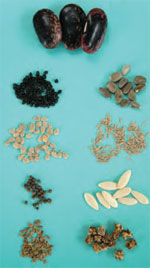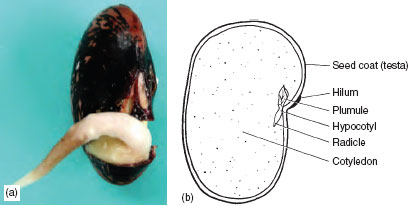The seed
Content
Seed structure The basic seed structure is shown in Figure 7.7. The main features of the seed are:
In some species, e.g. grasses and Ricinus (castor oil plant), the food of the seed is found in a different tissue from the cotyledons. This tissue is called endosperm and is derived from the fusion of extra cell nuclei, at the same time as fertilization. Plant food is usually stored as the carbohydrate, starch, formed from sugars as the seed matures, e.g. in peas and beans. Other seeds, such as sunflowers, contain high proportions of fats and oils, and proteins are often present in varying proportions. The seed is also a rich store of nutrients that it requires when a seedling, such as phosphate. The seed structure may be specialized for wind dispersal, e.g. members of the Asteraceae family, including groundsel, dandelion and thistle, which have parachutes, as does Clematis (Ranunculaceae). Many woody species such as lime (Tilia), ash (Fraxinus), and sycamore (Acer) produce winged fruit. Other seed-pods are explosive, e.g. balsam and hairy bittercress. Organisms such as birds and mammals distribute hooked fruits such as goosegrass and burdock, succulent types (e.g. tomato, blackberry, elderberry), or those that are filled with protein (e.g. dock). Dispersal mechanisms are summarized in Table 7.1. Seeds are contained within fruits which provide a means of protection and, often, dispersal. |
|||||||||||||||||||






